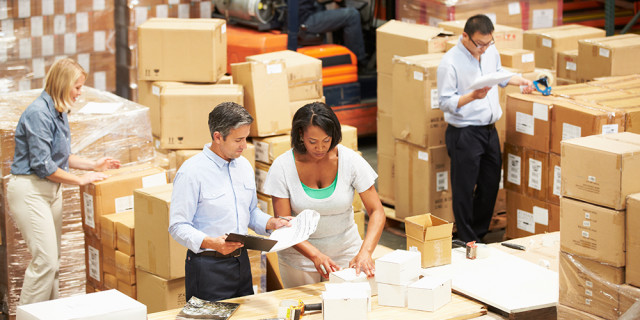How Does A Distribution Center Work?
Posted On June 2, 2015 by

A distribution center is a building used to receive and temporarily store goods that will be shipped to various destination points after orders are placed for these goods. Some massive retail chains own and operate their own distribution centers but many businesses choose to utilize a third party distribution center to reduce their operational overhead. These centers have the flexibility to warehouse goods that are redistributed to wholesalers, retailers and/or directly to customers simultaneously.
Some other common names for a distribution center are package handling center, warehouse or fulfillment center. Some are referred to as a cross-dock facility, bulk break center or simply as a DC (distribution center). The term used is based on the specific role the center will fulfill for a business. Package handling centers simply receive goods from one source and forward them to another. A fulfillment center commonly ships orders directly to customers who have ordered products through catalogs or online stores. Cross-dock facilities typically have no storage capacity and just transport goods from one shipping source to another from trucks to ships or trains and vice versa. A bulk break center receives shipping containers or pallets of goods that are broken down for distribution to various sources.
Distribution centers can range in size of less than 50,000 square feet up to 3 million square feet. A large center might receive and ship more than than a thousand truckloads each year, with an individual center receiving anywhere from a few trucks per week all the way up to 30 or more per week. In general, distribution centers are organized into three major sections; a shipping dock, receiving dock and storage zone. Each of these warehouse areas may be broken into specialized sections for different types of goods. For instance, if a company handles perishable and nonperishable goods, the distribution center will have a separate area equipped with air conditioning or refrigeration to safely store these products to keep them fresh. Docks frequently have specially designated areas to handle these goods for storage, transport or other special handling requirements.
The workflow and tasks of a full service distribution center starts from when goods are received from a source and ends when goods are received by the end user:
Goods In
Specialized containers are unloaded by forklift drivers and other staff may perform pallet wrapping and conveyor belt activity.
Bulk
The bulk department controls and ships larger orders or orders that contain only full cartons or boxes. Forklift drivers load containers and wagons and unload full pallets from warehouse racking.
Break bulk
Also known as split case, break bulk is a lower-capacity version of the bulk department. Orders usually contain part boxes or items that don’t require pallets. Trolleys are used for palleted/heavy orders or small electric PPT or walkie low lift trucks. Items stored in break bulk are stored in pick, which are usually the bottom two pick faces of warehouse racking. A pick face is the space on a racking system onto which a pallet can be loaded.
Export
An export department controls orders which are leaving the country and is almost identical in function to a bulk or break bulk department. They are additionally required to build pallets as needed in various standards and sizes and this department uses different shipping containers or haulage firms to bulk or break bulk departments.
Quality Assurance
The quality assurance (QA) department performs periodic checks of random samples of stock to ensure their condition meets a certain required standard. Products are checked throughout the warehouse racking, goods in and returned stock phases. The department may also do cycle counts to find missing stock.
Packing and Production
Packing benches are used to pack raw items at a specific unit quantity, then packed into cartons and labeled accordingly for a customer.
Transportation
The transportation staff arranges and coordinates inbound and outbound shipping of all products from the distribution center.
Special Handling
Some centers have additional departments designed specifically to handle products with special needs such as refrigerated products like meat and produce, frozen items, dairy, etc.

Distribution centers also maintain numerous supporting departments including human resources, maintenance and facilities operations, production control and accounting. The staff at these centers are divided into two categories, direct and indirect labor. http://riverplateinc.com/blog/how-does-a-distribution-center-work http://riverplateinc.com/blog/how-does-a-distribution-center-work http://riverplateinc.com/blog/how-does-a-distribution-center-work http://riverplateinc.com/blog/how-does-a-distribution-center-workThe direct labor staff executes the distribution processes while the indirect labor staff support the direct labor staff. Each department is composed of supervisors and warehouse workers with a general manager that oversees all department head managers that report directly to him or her.